Comparative Life Cycle Assessment Study on Carbon Footprint of Water Treatment Plants: Case Study of Indonesia and Taiwan
Abstract
:1. Introduction and Literature Review
1.1. Background
1.2. Water Treatment Process and Supply System
1.3. Life Cycle Assessment and Carbon Footprint of Water Treatment Plants
2. Materials and Methods
2.1. Study Area
2.2. Goal and Scope, Functional Unit and System Boundary Definition
2.3. Life Cycle Inventory Analysis and Impact Assessment
2.4. Limitation of This Study
- The system boundary includes raw water abstraction until the last step before clean water delivery to consumers.
- This study does not include the sludge treatment unit because some WTPs do not have sludge treatment facilities.
- Chemical transportation to the treatment plant is not included in our system boundary.
3. Results and Discussions
4. Conclusions
Supplementary Materials
Author Contributions
Funding
Institutional Review Board Statement
Informed Consent Statement
Data Availability Statement
Conflicts of Interest
References
- Tarpani RR, Z.; Lapolli, F.R.; Recio MA, L.; Gallego-Schmid, A. Comparative Life Cycle Assessment of Three Alternative Techniques for Increasing Potable Water Supply in Cities in the Global South. J. Clean. Prod. 2021, 290, 125871. [Google Scholar] [CrossRef]
- Boretti, A.; Rosa, L. Reassessing the projections of the World Water Development Report. Npj Clean Water 2019, 2, 15. [Google Scholar] [CrossRef]
- Water.org. Indonesia. 2022. Available online: https://water.org/our-impact/where-we-work/indonesia/ (accessed on 30 April 2024).
- World Health Organization (WHO); The United Nations Children’s Fund (UNICEF). Progress on Household Drinking Water, Sanitation and Hygiene 2000–2020: Five Years into the SDGs; WHO: Geneva, Switzerland, 2021. [Google Scholar]
- Permana, A. The Urgency of Maintaining Safe and Clean Water Availability in Indonesia; Institut Teknologi Bandung: Bandung, Indonesia, 2020; Available online: https://www.itb.ac.id/news/read/57576/home/the-urgency-of-maintaining-safe-and-clean-water-availability-in-indonesia (accessed on 30 April 2024).
- Delphos, P.J.; Wesner, G.M. Water Treatment Plant Design—Chapter 6: Mixing, Coagulation, and Flocculation; Mc Graw Hill: New York, NY, USA, 2005; ISBN 0-07-141872-5. [Google Scholar] [CrossRef]
- Sala-Garrido, R.; Mocholi-Arce, M.; Molinos-Senante, M.; Maziotis, A. Marginal Abatement Cost of Carbon Dioxide Emissions in the Provision of Urban Drinking Water. Sustain. Prod. Consum. 2020, 25, 439–449. [Google Scholar] [CrossRef]
- Agthe, D.E.; Billings, R.B.; Buras, N. Managing Urban Water Supply—Chapter 1: Introduction; Springer Science-Business Media: Dordrecht, Germany, 2003; ISBN 978-94-017-0237-9. [Google Scholar] [CrossRef]
- Ahuja, S. Handbook of Water Purity and Quality; Elsevier: Amsterdam, The Netherlands, 2009. [Google Scholar] [CrossRef]
- Mekonnen, M.M.; Hoekstra, A.Y. Four billion people facing severe water scarcity. Sci. Adv. 2016, 2, e1500323. [Google Scholar] [CrossRef] [PubMed]
- United Nations Water. The United Nations World Water Development Report 2019: Leaving No One Behind; UNESCO: Paris, Italy, 2019. [Google Scholar]
- Gerba, C.P. Drinking Water Treatment. In Environmental Microbiology; Academic Press: Cambridge, MA, USA, 2009; pp. 531–538. [Google Scholar] [CrossRef]
- Weiner, R.F.; Matthews, R.A. Environmental Engineering—Chapter 6: Water Supply; Chapter 7: Water Treatment; Elsevier: Philadelphia, PA, USA, 2003. [Google Scholar]
- Pizzi, N.G. Principles and Practices of Water Supply Operations Water Treatment, 4th ed.; American Water Works Association (AWWA): Denver, CO, USA, 2010; ISBN 978-1-58321-777-1. [Google Scholar]
- Marhaba, T.F. Monitoring Disinfectants. In Handbook of Water Purity and Quality; Academic Press: Cambridge, MA, USA, 2008; pp. 259–288. [Google Scholar] [CrossRef]
- Guinée, J.B. Handbook on life cycle assessment operational guide to the ISO standards. Int. J. Life Cycle Assess. 2002, 7, 311–313. [Google Scholar] [CrossRef]
- Hischier, R.; Weidema, B.P.; Althaus, H.-J.; Bauer, C.; Doka, G.; Dones, R.; Frischknecht, R.; Hellweg, S.; Humbert, S.; Jungbluth, N.; et al. Implementation of Life Cycle Impact Assessment Methods Data, v2.2. Eco-Invent Report No. 3; Swiss Centre for Life Cycle Inventories: Geneva, Switzerland, 2010. [Google Scholar]
- ISO 14040; Environmental Management—Life Cycle Assessment—Principles and Framework. ISO: Geneva, Switzerland, 2006.
- ISO 14044; Environmental Management Life Cycle Assessment Requirements and Guidelines. ISO: Geneva, Switzerland, 2006.
- Lakho, F.H.; Qureshi, A.; Igodt, W.; Le, H.Q.; Depuydt, V.; Rousseau DP, L.; van Hulle SW, H. Life cycle assessment of two decentralized water treatment systems combining a constructed wetland and a membrane based drinking water production system. Resour. Conserv. Recycl. 2022, 178, 106104. [Google Scholar] [CrossRef]
- Meron, N.; Blass, V.; Thoma, G. A national-level LCA of a water supply system in a Mediterranean semi-arid climate—Israel as a case study. Int. J. Life Cycle Assess. 2020, 25, 1133–1144. [Google Scholar] [CrossRef]
- Li, Y.; Xiong, W.; Zhang, W.; Wang, C.; Wang, P. Life cycle assessment of water supply alternatives in water-receiving areas of the South-to-North Water Diversion Project in China. Water Res. 2016, 89, 9–19. [Google Scholar] [CrossRef] [PubMed]
- Bonoli, A.; di Fusco, E.; Zanni, S.; Lauriola, I.; Ciriello, V.; di Federico, V. Green smart technology for water (GST4Water): Life cycle analysis of urban water consumption. Water 2019, 11, 389. [Google Scholar] [CrossRef]
- Godskesen, B.; Meron, N.; Rygaard, M. LCA of drinking water supply. In Life Cycle Assessment; Springer: Berlin/Heidelberg, Germany, 2018; pp. 835–860. [Google Scholar] [CrossRef]
- Zijp, M.C.; van der Laan, H. Life Cycle Assessment of Two Drinking Water Production Schemes; National Institute for Public Health and the Environment RIVM: Utrecht, The Netherlands, 2015. [Google Scholar]
- Ghimire, S.R.; Johnston, J.M.; Ingwersen, W.W.; Sojka, S. Life cycle assessment of a commercial rainwater harvesting system compared with a municipal water supply system. J. Clean. Prod. 2017, 151, 74–86. [Google Scholar] [CrossRef] [PubMed]
- Hsien, C.; Choong Low, J.S.; Chan Fuchen, S.; Han, T.W. Life cycle assessment of water supply in Singapore—A water-scarce urban city with multiple water sources. Resour. Conserv. Recycl. 2019, 151, 104476. [Google Scholar] [CrossRef]
- Calvin, K.; Lee, H.; Dasgupta, D.; Krinner, G.; Mukherji, A.; Thorne, P.; Trisos, C.; Romero, J.; Aldunce, P.; Barett, K.; et al. IPCC, 2023: Climate Change 2023: Synthesis Report. Contribution of Working Groups I, II and III to the Sixth Assessment Report of the Intergovernmental Panel on Climate Change; Core Writing Team, Lee, H., Romero, J., Eds.; Intergovernmental Panel on Climate Change (IPCC): Geneva, Switzerland, 2023. [Google Scholar] [CrossRef]
- BPS Statistics of Surabaya Municipality. Surabaya Municipality in Figures 2021; Badan Pusat Statistik Kota Surabaya: Surabaya, Indonesia, 2021. [Google Scholar]
- Surabaya City Water Supply Company. Surabaya City Water Supply Company 2021 Report; Surabaya City Water Supply Company: Surabaya, Indonesia, 2021. [Google Scholar]
- Taipei City Government. Taipei City Statistical Yearbook 2020; Taipei City Government: Taipei, Taiwan, 2021. [Google Scholar]
- Taipei Water Department. Taipei Water Department Statistical Yearbook 2020; Taipei Water Department: Taipei, Taiwan, 2021; ISSN 1812-3104. [Google Scholar]
- Ministry of Energy and Mineral Resources Republic of Indonesia. Handbook of Energy & Economic Statistic of Indonesia 2020; Ministry of Energy and Mineral Resources Republic of Indonesia: Jakarta, Indonesia, 2021; ISSN 2528-3464. [Google Scholar]
- Ministry of Economic Affairs Energy Administration. 2022 Electricity Carbon Emission Factor; Energy Administration; Ministry of Economic Affairs Energy Administration: Taiwan, China, 2022. Available online: https://www.moeaea.gov.tw/ECW/english/content/Content.aspx?menu_id=24200 (accessed on 6 August 2024).
- DatabaseManualMethods.pdf. Available online: https://simapro.com/wp-content/uploads/2020/10/DatabaseManualMethods.pdf (accessed on 15 September 2024).
- Hu, A.H.; Wang, L.H.; Fan, C.W.; Lin, Y.Z.; Lin, J.H.; Yao, K.F.; Nien, P.F.; Feng, Y.T.; Kuo, W.M. Carbon Footprint Assessment of Water Supply Systems in Taiwan. In Design for Innovative Value towards a Sustainable Society; Springer: Berlin/Heidelberg, Germany, 2012; pp. 318–322. [Google Scholar] [CrossRef]
- Ministry of Digital Affairs. The Taiwan Water Corporation CO2 emissions per unit of water consumed|政府資料開放平臺. Available online: https://data.gov.tw/en/datasets/25681 (accessed on 15 September 2024).
- Biswas, W.K.; Yek, P. Improving the carbon footprint of water treatment with renewable energy: A Western Australian case study. Renew. Wind. Water Sol. 2016, 3, 14. [Google Scholar] [CrossRef]
- Sambito, M.; Freni, G. LCA Methodology for the Quantification of the Carbon Footprint of the Integrated Urban Water System. Water 2017, 9, 395. [Google Scholar] [CrossRef]
- Sari, E.; Kristanto, G.A.; Pratama, M.A. Green House Gasses Estimation from Clean Water Production and Supply Sector in Depok City, Indonesia. AIP Conf. Proc. 2020, 2230, 040015. [Google Scholar] [CrossRef]
- Presura, E.; Robescu, L.D. Energy use and carbon footprint for potable water and wastewater treatment. Proc. Int. Conf. Bus. Excell. 2017, 11, 191–198. [Google Scholar] [CrossRef]
- Modolo, S.D.; Telukdarie, A.; Kumar, A. Energy-water and GHG Nexus: A South African Water Industry Case. Water Pract. Technol. 2018, 13, 673–691. [Google Scholar] [CrossRef]
- Hofs, B.; van den Broek, W.; van Eckeveld, A.; van der Wal, A. Carbon Footprint of Drinking Water Over Treatment Plant Life Span (2025–2075) is Probably Dominated by Construction Phase. Clean. Environ. Syst. 2022, 5, 100079. [Google Scholar] [CrossRef]
- Borzooei, S.; Campo, G.; Cerutti, A.; Meucci, L.; Panepinto, D.; Ravina, M.; Riggio, V.; Ruffino, B.; Scibilia, G.; Zanetti, M. Feasibility Analysis for Reduction of Carbon Footprint in a Wastewater Treatment Plant. J. Clean. Prod. 2020, 271, 122526. [Google Scholar] [CrossRef]

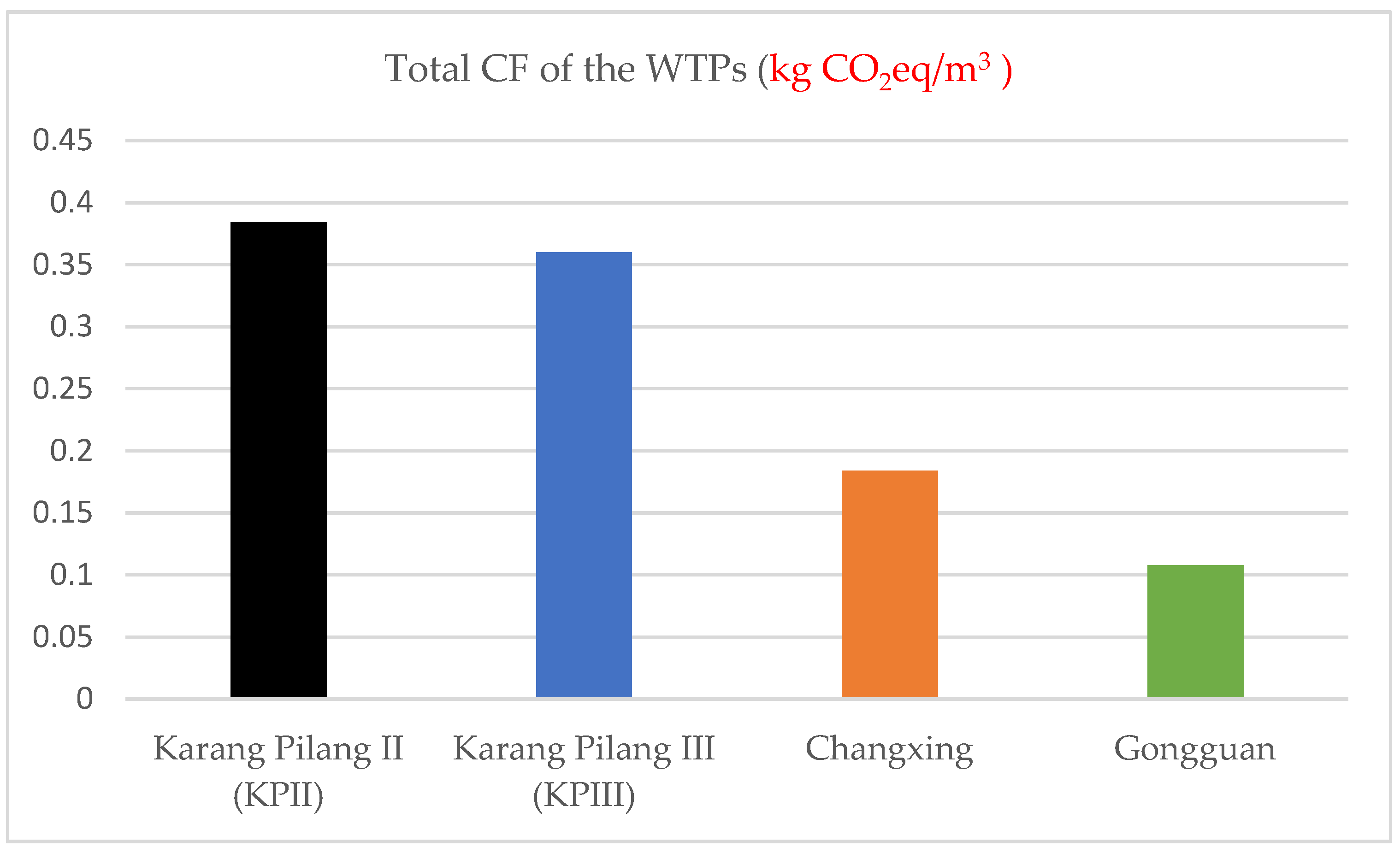
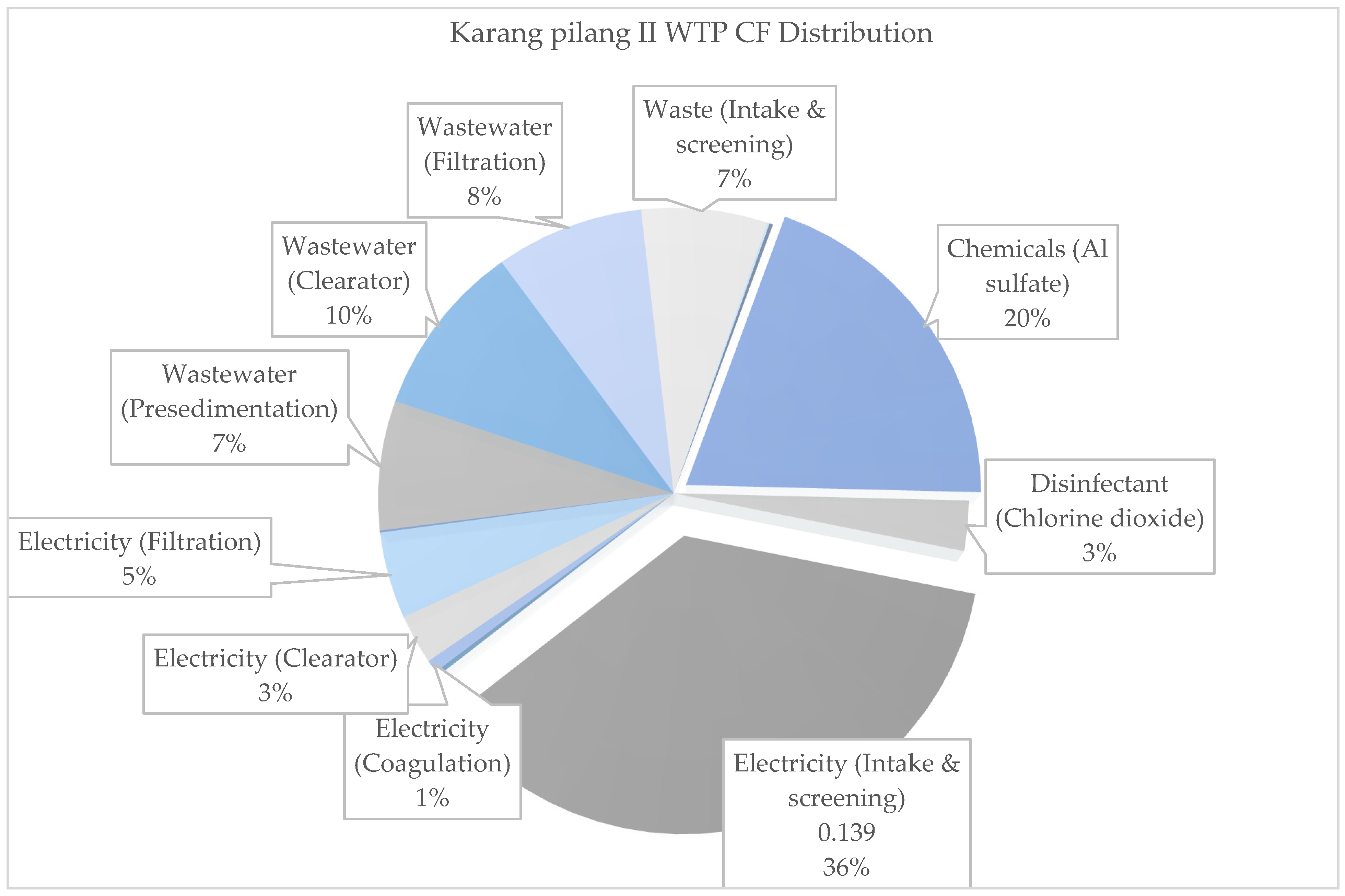

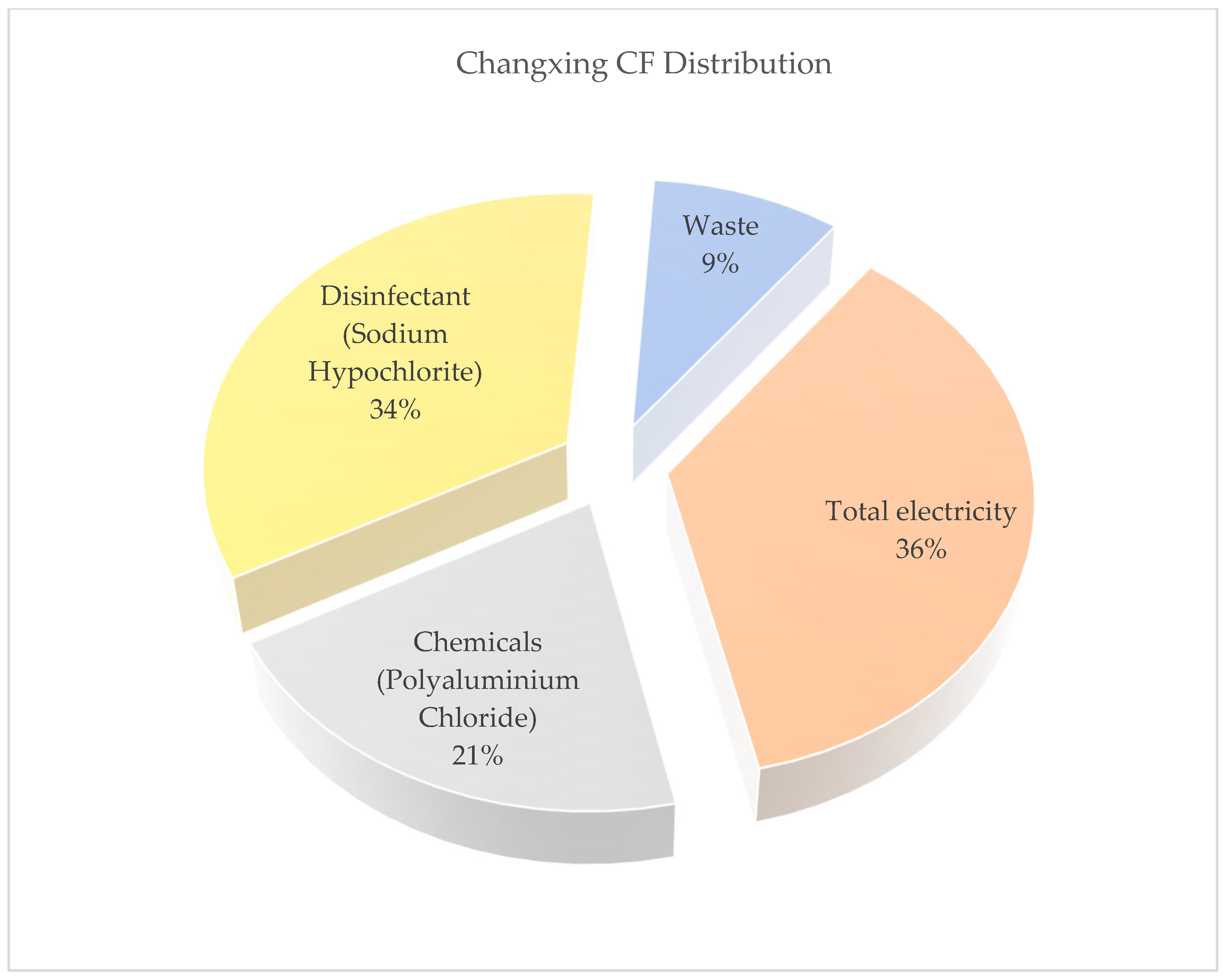
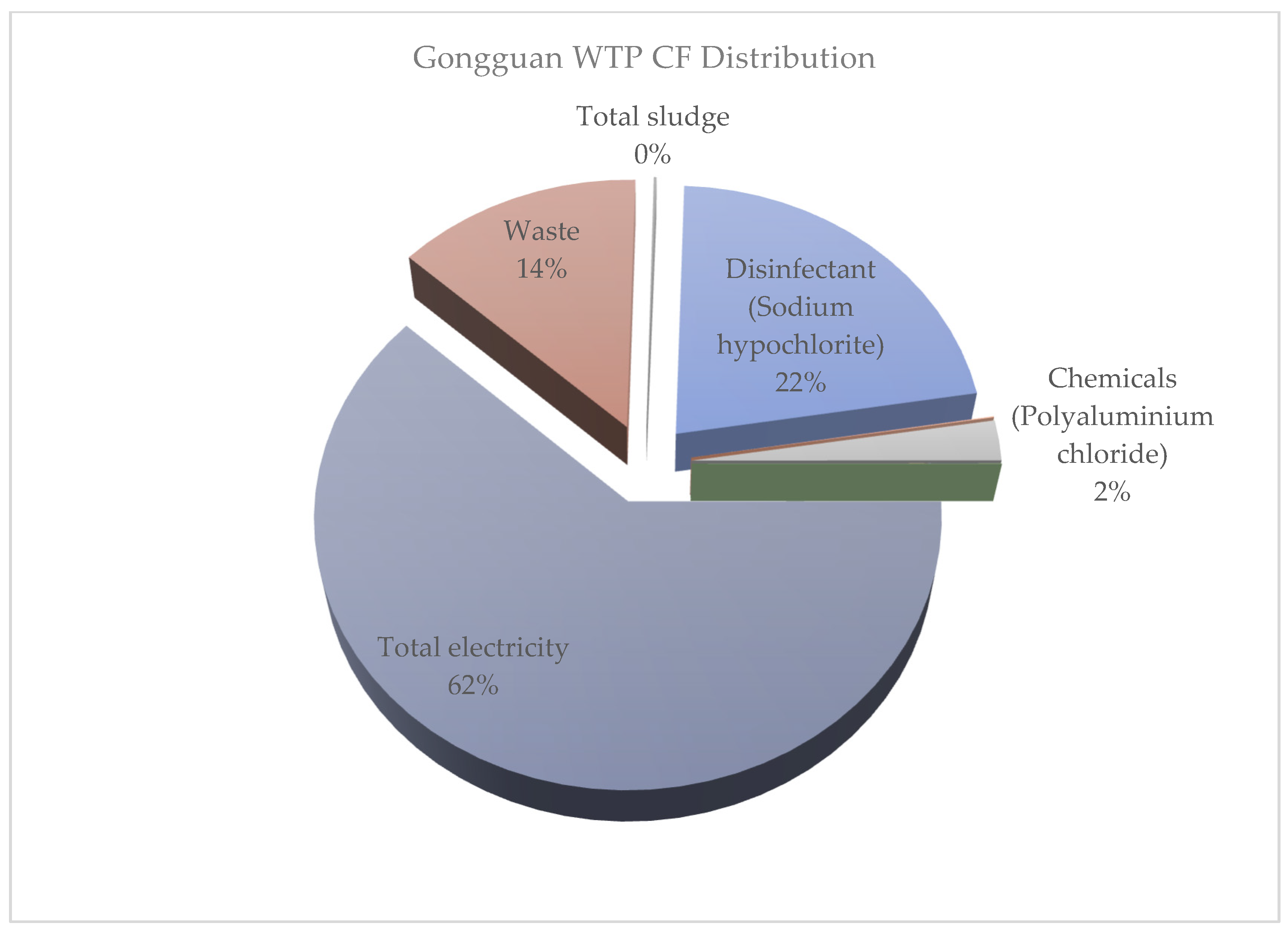
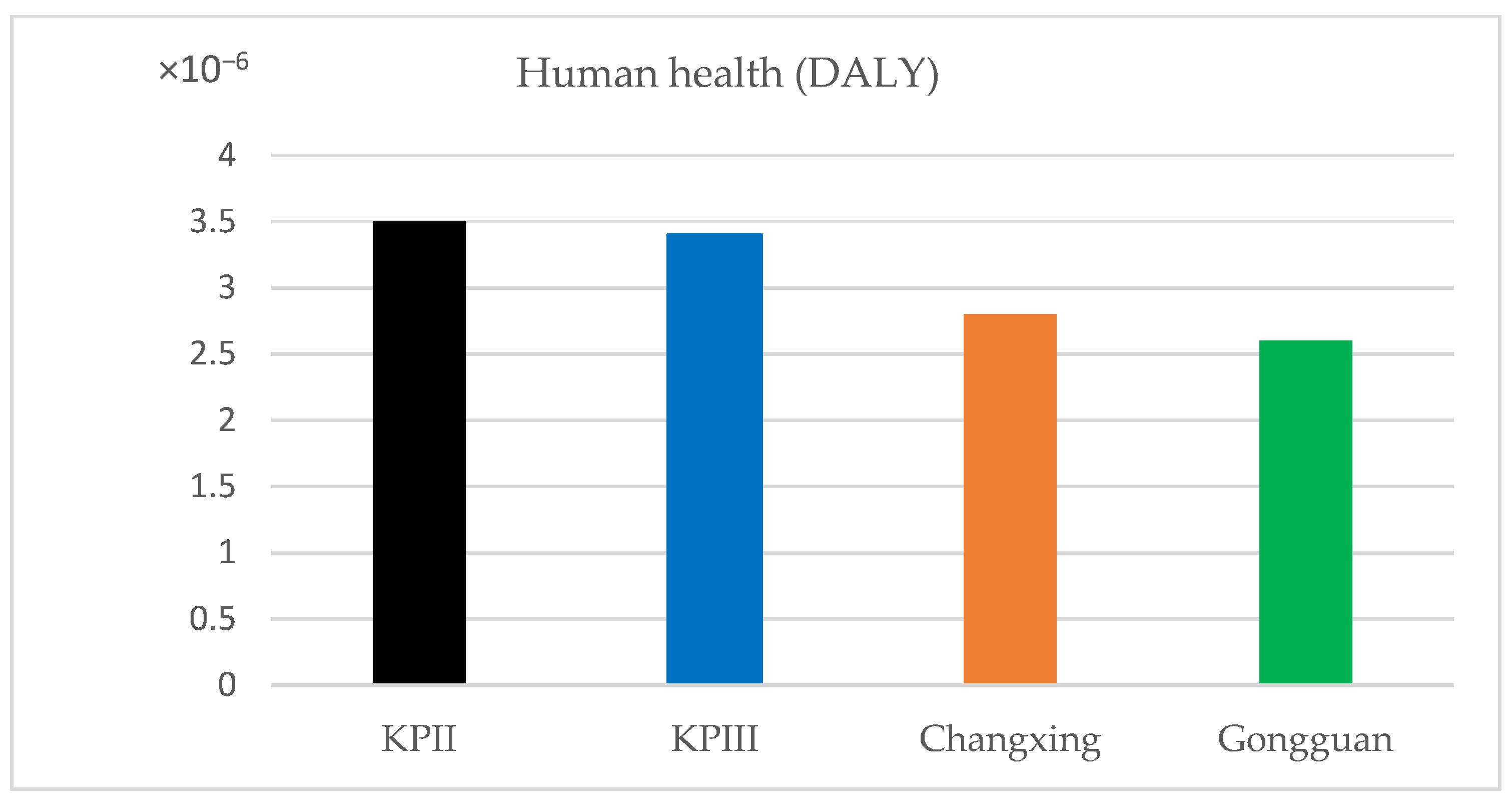
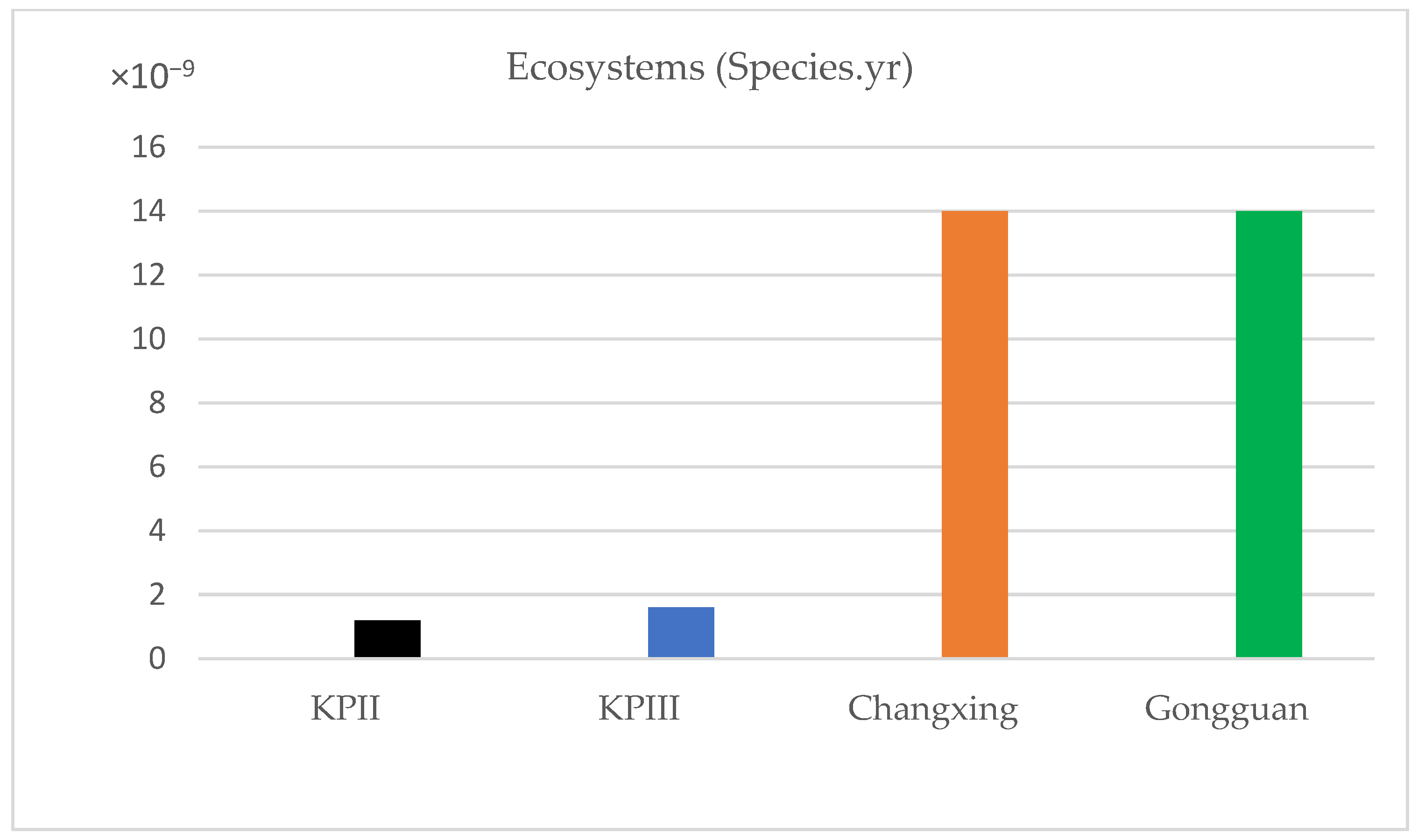

| Unit | Indonesia | Taiwan | |
|---|---|---|---|
| Karang Pilang II | Karang Pilang III | Changxing, Gongguan | |
| Intake and screening | Yes | Yes | Yes |
| Aerator | Yes | No | No |
| Pre-sedimentation tank | Yes | Yes | Yes |
| Coagulator | Yes | Yes | Yes |
| Flocculator | No | No | Yes |
| Clearator | Yes | Yes | No |
| Sedimentation tank | No | No | Yes |
| Filters | Yes | Yes | Yes |
| Disinfector | Yes | Yes | Yes |
| Reservoir | Yes | Yes | Yes |
| Water Treatment Plant | Average Treatment | Total CF (kg CO2eq/m3) |
|---|---|---|
| Karang Pilang II (KPII) | 266,025.80 m3/day | 0.384 kg CO2eq/m3 |
| Karang Pilang III (KPIII) | 235,996.40 m3/day | 0.360 kg CO2eq/m3 |
| Changxing | 314,124.02 m3/day | 0.184 kg CO2eq/m3 |
| Gongguan | 237,186.91 m3/day | 0.108 kg CO2eq/m3 |
| Impact Category | Unit of Measurement | Karang Pilang II | Karang Pilang II | Changxing | Gongguan |
|---|---|---|---|---|---|
| Global warming | kg CO2eq | 0.390 | 0.365 | 0.186 | 0.109 |
| Stratospheric ozone depletion | kg CFC11 eq | 4.1 × 10−7 | 3.4 × 10−7 | 1.5 × 10−7 | 9.0 × 10−8 |
| Ionizing radiation | kBqCo−60 eq | 0.011 | 0.010 | 0.027 | 0.021 |
| Ozone formation, human health | kgNOx eq | 0.001 | 0.001 | 3.3 × 10−4 | 1.2 × 10−4 |
| Fine particulate matter formation | kg PM2.5 eq | 0.005 | 0.005 | 4.4 × 10−4 | 2.6 × 10−4 |
| Ozone formation, terrestrial ecosystems | kg NOx eq | 0.001 | 0.001 | 3.3 × 10−4 | 1.3 × 10−4 |
| Terrestrial acidification | kgSO2 eq | 0.002 | 0.002 | 0.001 | 4.3 × 10−4 |
| Freshwater eutrophication | kg P eq | 0.001 | 0.001 | 1.5 × 10−4 | 1.1 × 10−4 |
| Marine eutrophication | kg N eq | 0.001 | 0.001 | 1.6 × 10−4 | 1.6 × 10−4 |
| Terrestrial ecotoxicity | kg 1,4-DCB | 1.163 | 1.109 | 0.499 | 0.249 |
| Freshwater ecotoxicity | kg 1,4-DCB | 0.021 | 0.020 | 0.010 | 0.007 |
| Marine ecotoxicity | kg 1,4-DCB | 0.029 | 0.027 | 0.014 | 0.009 |
| Human carcinogenic toxicity | kg 1,4-DCB | 0.065 | 0.063 | 0.029 | 0.010 |
| Human non-carcinogenic toxicity | kg 1,4-DCB | 0.904 | 0.784 | 0.251 | 0.168 |
| Land use | m2 a crop eq | 0.006 | 0.006 | 0.003 | 0.002 |
| Mineral resource scarcity | kg Cu eq | 0.004 | 0.004 | 0.004 | 0.003 |
| Fossil resource scarcity | kg oil eq | 0.106 | 0.101 | 0.052 | 0.033 |
Disclaimer/Publisher’s Note: The statements, opinions and data contained in all publications are solely those of the individual author(s) and contributor(s) and not of MDPI and/or the editor(s). MDPI and/or the editor(s) disclaim responsibility for any injury to people or property resulting from any ideas, methods, instructions or products referred to in the content. |
© 2024 by the authors. Licensee MDPI, Basel, Switzerland. This article is an open access article distributed under the terms and conditions of the Creative Commons Attribution (CC BY) license (https://creativecommons.org/licenses/by/4.0/).
Share and Cite
Ouattara, A.; Azhaari, R.N.N.; Hu, A.H.; Kuo, C.-H.; Huang, H. Comparative Life Cycle Assessment Study on Carbon Footprint of Water Treatment Plants: Case Study of Indonesia and Taiwan. Sustainability 2024, 16, 8409. https://doi.org/10.3390/su16198409
Ouattara A, Azhaari RNN, Hu AH, Kuo C-H, Huang H. Comparative Life Cycle Assessment Study on Carbon Footprint of Water Treatment Plants: Case Study of Indonesia and Taiwan. Sustainability. 2024; 16(19):8409. https://doi.org/10.3390/su16198409
Chicago/Turabian StyleOuattara, Ali, Resita Nadya Noor Azhaari, Allen H. Hu, Chien-Hung Kuo, and Hongwei (Lance) Huang. 2024. "Comparative Life Cycle Assessment Study on Carbon Footprint of Water Treatment Plants: Case Study of Indonesia and Taiwan" Sustainability 16, no. 19: 8409. https://doi.org/10.3390/su16198409







